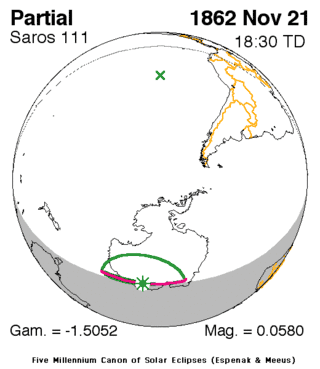Solar eclipse of November 21, 1862
A partial solar eclipse occurred on November 21, 1862 during spring. A solar eclipse occurs when the Moon passes between Earth and the Sun, thereby totally or partly obscuring the image of the Sun for a viewer on Earth. A partial solar eclipse occurs in the polar regions of the Earth when the center of the Moon's shadow misses the Earth. As is shown under 6% obscuration, the center of the Moon's shadow was missed by about 2,670 km above the area (68 S) south of the Antarctic Circle.
| Solar eclipse of November 21, 1862 | |
|---|---|
 Map | |
| Type of eclipse | |
| Nature | Partial |
| Gamma | -1.5052 |
| Magnitude | 0.058 |
| Maximum eclipse | |
| Coordinates | 68.8°S 99.1°E |
| Times (UTC) | |
| Greatest eclipse | 18:29:48 |
| References | |
| Saros | 111 (75 of 79) |
| Catalog # (SE5000) | 9194 |
It was the first of three partial eclipses that took place that year, the last occurred in the same hemisphere on June 27, nearly on the opposite side of the previous eclipse.[1] It was the last three of the solar saros 111, the next was on December 2, 1880 and the last was on January 5, 1935.[2]
Description
The eclipse took place in a part of Northern Antarctica (in areas that had a 24-hour daylight at the time) to the area separating the Indian and Pacific Ocean, to the range of 170th meridian east and up to around the 50th meridian east.[1] The eclipse started at sunrise in the Indian Ocean and ended at sunset in Antarctica. A very small part occurred on the location of the previous eclipse, many areas occurred on the opposite side. The greatest eclipse was off the shore of Antarctica at 68.8 S and 99.1 E at 18:29 UTC (10:42 AM local time).[1]
The subsolar marking was in the Pacific Ocean around the Tropic of Capricorn.
The next solar eclipse which occurred in the same area was an annular eclipse on November 11, 1863, parts were inside the umbral portion.
See also
- List of solar eclipses in the 19th century
- List of solar eclipses visible from Antarctica
References
- "Solar eclipse of June 27, 1862". NASA. Retrieved March 21, 2017.
- "Solar Saros 11". NASA. Retrieved March 21, 2017.
.jpg.webp)


